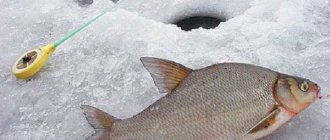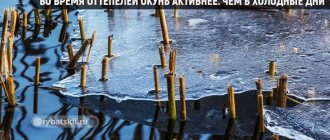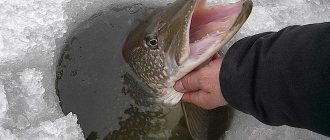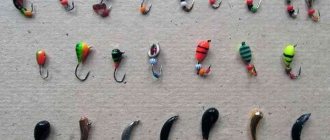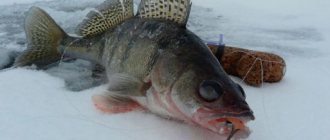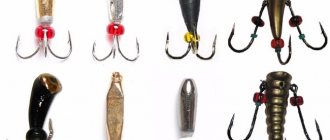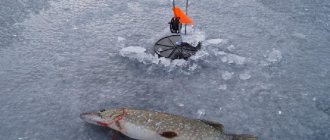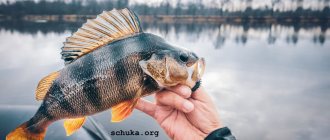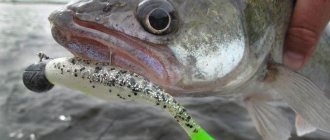Crucian carp can be classified as a fish that actively reacts to jigs. In their appearance and the parameters of the classic game with a winter fishing rod, they remind him of his favorite underwater victims. These prey imitators, if they are of good quality, with miniature sizes, create waves in the water that spread well and are registered by the lateral lines of the fish.
Most jigs for crucian carp in winter are additionally equipped with bait of various types, hence the active winter bite of this fish becomes quite understandable. Which bait for crucian carp is best in winter is determined on the ice with a fishing rod. Fishing on each body of water has its own secrets and features.
Catching crucian carp with a jig
Crucian carp is excellently caught not only in summer, but also in winter. The best time to catch crucian carp is in November, when the first ice appears on the lakes. A jig for crucian carp is the same catchy tackle in the winter as a float rod with an animal bait in the summer. When persistent cold sets in, and lakes with stagnant water are covered with ice of sufficient thickness, the fish hibernate. But in reservoirs where there is a slight current that enriches the water with oxygen, fish bite well in winter, just as in summer.
You will have good luck catching crucian carp in winter using a jig during thaw periods, when the weather is sunny and the atmospheric pressure is favorable for biting. On such days, the fish are active, they quickly move around the reservoir in search of food. A good bite is observed not only during the day, but also at night. However, when it snows, the fish lies down on the bottom silt and stops responding to any bait.
For winter fishing for crucian carp, ordinary ice fishing gear is used, made according to the same principle as any float fishing rod. There is also a summer jig for crucian carp, which is successfully used by experienced fishermen.
It is convenient to use a winter fishing rod (or fishing rod) of the required size with a nod from the ice, equipped with a jig. To easily pull the fish out of the hole even in severe frosts, grasping the fishing line with your hands, you need a small whip. The nod at the end of the fishing rod is a kind of signaling device and bite regulator; it is selected according to the weight of the jigs used.
It’s worth talking in more detail about which jigs are more suitable for winter fishing for each fish and about other elements of ice fishing equipment.
How to choose tackle?
By shape
Crucian carp does not pay much attention to the shape of the jig, so you should not strive for complex shapes, but use the simplest ones.
By color
The most commonly used jigs are natural colors:
- lead;
- tin;
- unpainted tungsten;
- copper;
- brass.
However, sometimes better results can be achieved by using bright jigs, for example, yellow and red, and even with a spiral contrasting pattern. Bright jigs are recommended for use in cloudy weather.
When stationary fishing on leashes, jigs with a light accumulator are tied above the sinker, which are especially effective for night fishing, but can also show good results during daylight hours.
By weight
When choosing a jig for catching crucian carp, you should use the rule: the lighter, the better. The jig needs to look small, so tungsten baits are often used.
Weather for crucian carp fishing in winter
The behavior of fish under ice is greatly influenced by the weather, primarily atmospheric pressure. In addition to water pressure, fish are also affected by the pressure of the air column of the atmosphere. If the pressure increases, then the air bubble of each fish experiences a significant overload - for free swimming, the same pressure must be created in the bubble as outside.
If the pressure changes quickly, the fish emerges to the surface of the water, greedily swallowing air or, conversely, releasing it. The best days for biting are when the atmospheric pressure is 750 mm Hg. Art. The fish leads an active lifestyle, visits feeding areas and readily bites. When the atmospheric pressure changes, crucian carp prefers to rise to the surface of the ice or, conversely, sink to the silt in places of deep water; its bite at this time is very sluggish.
Air temperature, water temperature and the presence of precipitation play a significant role. Fishing is successful during warming weather. If the weather has not changed for several days, this is a good signal to go out on the ice with a fishing rod.
Long cloudy or changeable weather with light snow helps to intensify the bite. But fish don’t like sudden temperature changes. If there is a large difference between day and night temperatures, there will be no bite.
Where to catch crucian carp in winter
In winter, crucian carp prefers areas of the reservoir where the bottom is covered with sand or a thin layer of silt. On the muddy bottom, he quickly plunges into winter sleep, burrowing deeper. If the layer of silt in the pond is not thick and it is impossible to bury yourself in it, the fish leads an active lifestyle, and winter fishing will be successful.
Fish in the active life phase visit the deepest places to rest, and to feed they go to medium depths, closer to snags, reeds or springs. The favorite areas for fish to be found are streams flowing into the lake; they feed the water with air and ensure the livelihoods of all inhabitants. Having studied these features of the reservoir, you can understand how to catch crucian carp and what gear to use for this.
Where to look for prey?
Mostly in winter, crucian carp are caught at shallow depths: from 1 to 3 meters. Promising places are uneven terrain and areas near plants frozen in the ice. Crucian carp avoids a clean sandy bottom, so a certain amount of silt in the soil must be present.
Expert opinion
Knipovich Nikolai Mikhailovich
Zoologist, hydrobiologist. I am interested in fishing at a professional level.
In cloudy weather, crucian carp stays deeper, and in sunny weather they can go into shallow water. The confluence of streams is extremely attractive for crucian carp.
Technique for catching crucian carp with a jig
There are many techniques for winter fishing for crucian carp with a jig that consistently give good results on ice fishing. Some fishermen play with bait, then lower it to the bottom and wait for the fish to approach. The game with bait is played according to certain rules, the movements of the jig are smooth, careful, breaks between retrieves are at least 10 seconds. Too frequent and sharp manipulations will scare away the fish and catching crucian carp with a jig will be ruined.
Do not rely on a fishing method where jigs for crucian carp with bait simply lie on the bottom of the reservoir or are suspended motionless at a certain depth. This bait does not attract the attention of fish. By using a ready-made crucian carp jig, the likelihood of success increases. Fishermen on the same body of water use different types and types of jigs and attachments, while achieving quite impressive results.
There are many websites on the Internet with detailed tips on how to catch crucian carp in winter. For fishermen without experience, this is a real storehouse of knowledge that can provide a catch on their first trip to the ice. There you can also determine the catchability of jigs of different shapes and designs, find out the main types of bait play and which winter baits are the most catchy.
Fishing tactics
It was believed that fishing for crucian carp in winter was unrealistic, and fishermen who targeted this fish from the ice would be caught out. But numerous fishing trips prove the opposite - from under the ice this fish can bite just as well as in the summer on a float rod.
In a winter reservoir, it is found in schools in places whose depth is more than half the maximum depth of the pond. A good bite usually begins in the afternoon, when the sun begins to warm up the water. If at this time you pour bait with bloodworms into the hole, the fish begins to actively rummage through it, looking for its favorite delicacy - mosquito larvae.
In winter, bait a few bloodworms in the form of a bunch on the hook of a jig for crucian carp; he definitely won’t be able to bypass this delicacy. Such well-known bait as semolina or a piece of earthworm is also suitable as a bait on a hook for winter fishing.
There is no need to immediately start active play with the jig; just tap it on the ground several times and place it on the bottom - the bite will not be long in coming. Not only crucian carp bites in these conditions, roach and perch can also join in the bite.
Fishing does not require particularly sensitive equipment; you can use summer tackle with a float. The main thing is to lure the fish under the hole, then the carp’s pickiness in biting and the habit of reliably swallowing the bait will play a role.
Types of nozzle jigs
In terms of its design, this type of bait is practically no different from classic jigs - a weight with a hook soldered into it. But still there are some differences. For example, the shape of mothless insects usually resembles some kind of insects and bugs. The location of the jig is in most cases vertical or at a slight angle. The most common and catchy reelless jigs are:
- Ant
- Devil
- Uralka
- Nymph
- Goat
In addition to those listed above, there are many other species, but most often these are the ones that can be found in the arsenal of fishermen.
Jigs of the “Ant” type
A well-proven bait for catching perch. As a rule, it is equipped with additional colored beads or cambrics to increase the interest of the fish.
Based on the name of the jig, it becomes clear what insect it imitates. A smooth rise with slight vibrations and swaying is suitable as a game.
Tips for a fisherman: How to properly attach a maggot to a jig in winter - What is the difference, pros and cons
Devil
Lately, catching perch in winter using the devil has become popular. This type of jig is suitable for almost any wiring and game. In addition to perch, other fish also bite the devil - roach, chub, ide.
The shape of the bait resembles a dragonfly larva and has 3 hooks. For wiring, lifting a jig with a blunt jig with fast and small vibrations works well.
Catching perch with devil in winter (video):
Uralka
The shape of the bait resembles an ordinary droplet with a slight deviation of the upper part from the vertical axis. Shows its effectiveness with classic wiring with smooth rocking and oscillations. Works well during periods of low perch activity. It can also be additionally equipped with beads.
Nymph
The performance of this type of jig is selected by putting on additional cambrics. Their number changes the location of the bait in the water and, accordingly, the game. You need to play as a nymph with high-frequency vibrations with ups and downs.
In appearance and shape it is very similar to the “Uralka”. The game of the “goat” is smoother and slower, so this jig works well during the already established winter, when the perch becomes less active and it is difficult to swing it to bite. It is also equipped with different cambrics and beads to increase the effect.
To catch roach, small reelless reels are used , less often - medium-sized ones. Standard weight – 0.1-0.3 g.
How to catch crucian carp in December
At the beginning of winter, during the first freeze-up, crucian carp can be caught in several ways:
- on a float rod;
- jig with attachments;
- nozzle jig.
Fishermen’s favorite method of fishing in December is with a jig. The choice of weight, size and shape of the jig depends on the characteristics of the reservoir where the fishing will be done. It is advisable to have different types of jigs in stock, differing not only in shape and size, but also in color. More often, fish bite on medium-sized jigs.
A special feature of crucian carp fishing in December is that small-sized fish do not actively search for food; only larger specimens peck on a jig. In the first winter month, a school of fish stays close to the shore, near thickets of reeds or cattails. Drill holes along the shore, purposefully looking for crucian carp and not paying attention to the bite of roach or perch.
It is impossible to predict the winter habitat of fish, but if it is found, you can confidently visit it day after day - crucian carp does not leave its favorite places for a long time. A fisherman accustomed to summer fishing can easily use a float rod with a jig from the ice. The float replaces the sensitive nod that signals a bite.
Float gear for ice fishing is good because the float allows you to place the hook at any distance from the bottom, up to one or two centimeters. A good option is when the jig remains suspended, and the hook and bait lie on the ground. Choose a hook that is not too small, no smaller than size 3, otherwise when hooking there is a high probability of it slipping out of the crucian’s mouth.
Having picked up the key to the fish in December, the fisherman will find its habitat in the dead of winter. To do this, you need to know the features of the reservoir well and carry out test drilling more often in its different places.
Features of choosing a place
Choosing a good fishing spot for crucian carp in December is not easy; on each body of water this choice must be made taking into account completely different factors. If there is a thick layer of silt at the bottom, then successful fishing will not work. The fish burrows into the silt, it saves them from oxygen starvation and predators and allows them to find a minimum amount of food.
In lakes where the bottom is sandy or the layer of silt is quite thin, the fish are constantly moving. In good sunny weather, it visits small places, entering its favorite thickets of grassy vegetation near the shore. Fishing for crucian carp in winter on a pond is successful where there are differences in the depths of the reservoir.
There are ponds where crucian carp settle in reed thickets from December for the rest of the winter. Skilled fishermen have invented ways to catch this fish in islands of dense bottom vegetation.
Features of December bait
Using bait for fish in December is just as important as in summer. In December, crucian carp are fed with breadcrumbs or pressed from sunflower and flax, this is called makukha. To bait fish in the pond, places where reeds grow abundantly are used.
The bait must contain bait that will be attached to the hook - a worm or bloodworm. The mixture of ingredients is molded into lumps, which are lowered into the hole at the fishing site. The bait put on the hook is flavored with attractants. If the bite does not start within an hour after feeding, change the place. Fishermen who find crucian carp sites will take home more than a dozen of the desired fish.
Fishing technique on first ice
Fishing for crucian carp with a jig is not difficult. His technique involves tightening the nozzle in the bottom area, slowly lowering it and then lifting it. During this activity, the fisherman does not always see the bite; it is hardly noticeable. When the bait is completely captured by the fish, the nod will shudder sharply and go down.
A variety of jigs are used for catching crucian carp in winter, originally intended for fish of other species. Crucian carp is not picky; it is interested in any noticeable objects that move in the water. Large crucian carp are caught on large hooks above the third number.
When fishing is done with float tackle, a bite is signaled by the float moving to the side. These are the moments when the crucian carp tries the bait. When the float begins to quickly sink into the water, you should make a hook.
Nozzle for catching crucian carp in December
The main food of crucian carp at the beginning of winter is bloodworms; it should be used as bait when catching this fish with a jig from the ice. Medium-sized or small bloodworms are suitable for fishing, but they are placed on hooks in a “bundle”, that is, several worms at once. If the bite is weak and the bloodworm has expired on the hook, it is replaced - there is no good bite on an empty bait.
Catching crucian carp in December with a jig without a bait will not be as successful as with a bloodworm or worm. Ordinary earthworms are also suitable for December bait, but they need to be prepared in advance, when the ground is not frozen and not covered with snow.
A good bite of crucian carp in December occurs on dough prepared on the basis of rye or wheat flour. A little honey and egg yolk are added to this nozzle.
Tackle
Any tackle for catching crucian carp in winter includes the following elements:
Fishing rod
The fishing rod can be equipped with a reel, or it can be made in the form of a “filly”.
- For running fishing with a jig, no matter with a reelless jig or a jig with an attachment, it is recommended to use balalaika-type fishing rods.
- For stationary fishing, you can use any type of fishing rod, provided that it is equipped with devices for securely fixing it on the ice.
fishing line
To catch crucian carp, use monofilament fishing line with a diameter of 0.1 mm.
Expert opinion
Knipovich Nikolai Mikhailovich
Zoologist, hydrobiologist. I am interested in fishing at a professional level.
For fishing with baitless jigs, the thickness of the fishing line should not exceed 0.14 mm. Only with a sufficiently thin fishing line can the desired play of the jig be ensured.
Nod
The nod is used for both active and passive fishing.
If stationary fishing does not require any subtleties from the design of the nod, since it should only show the moment of the bite, then when actively fishing with a jig, especially with a reelless one, the nod plays an important role as an animator of the bait. In addition, it must clearly record even the weakest bite. Nods for baitless fishing can reach a length of 20 cm. Good nods are made of lavsan, less often a clock spring is used.
Float
The float replaces the nod for stationary fishing. There are two ways to load a float:
- With one, a fairly heavy load keeps the float submerged and only detects a “flood” bite.
- With the second, all the weight is balanced with the carrying capacity of the float, and when biting, the latter reacts very sensitively to the bite, since the fish practically does not feel resistance.
How to make a jig for crucian carp with your own hands
To catch crucian carp on a fishing line in summer, one hook is enough; in winter, you can’t do without a jig. To make a jig with your own hands at home, you do not need a warehouse of tools and materials. All you need is a soldering iron, a piece of tin and plaster for the mold.
Sometimes pieces of sheet metal, scraps of non-ferrous alloys, cupronickel, stainless steel, and tin strips from coffee cans are used.
Choose the shape of your future homemade product in advance, as it greatly affects how the product plays in the water. When searching for food, fish rely on hearing and vision. It’s easier to make a small mold and, putting a hook in there, fill it with molten tin or lead using a soldering iron. When the metal has hardened, all that remains is to process the product with a file or sandpaper, bringing it to the required shape and shine.
To make phosphorus jigs, use luminous compounds that are sold in fishing stores. The color of the jig is determined by the material used for its manufacture or the dyes available to the craftsman.
